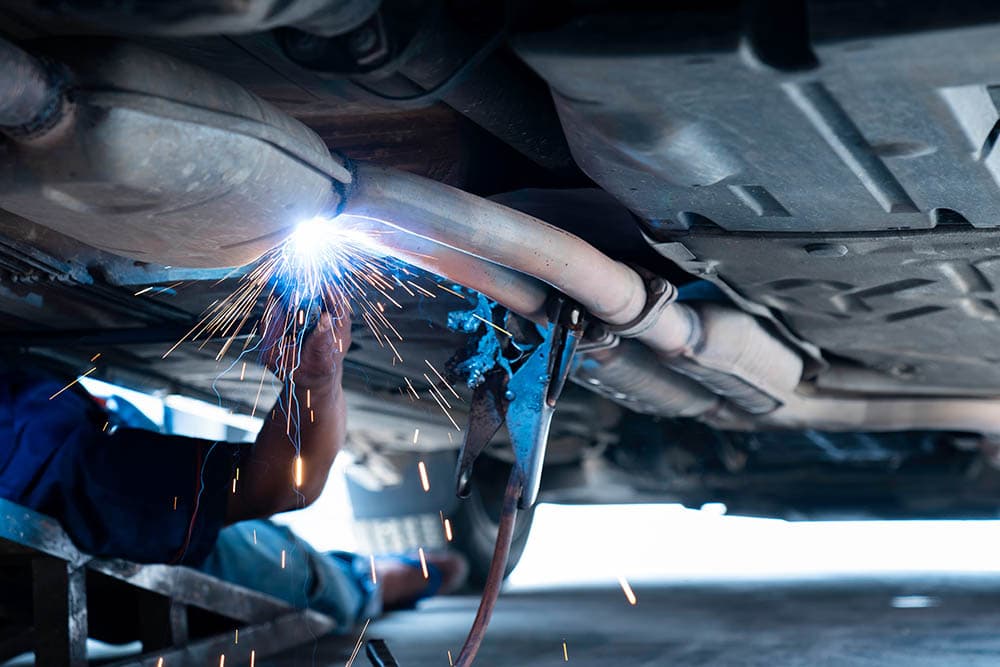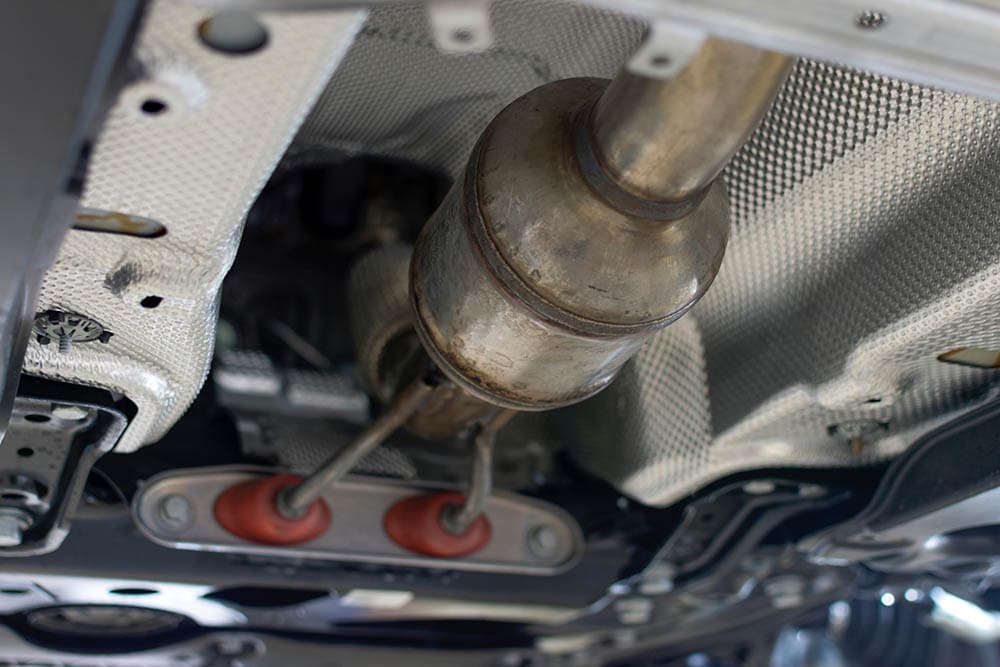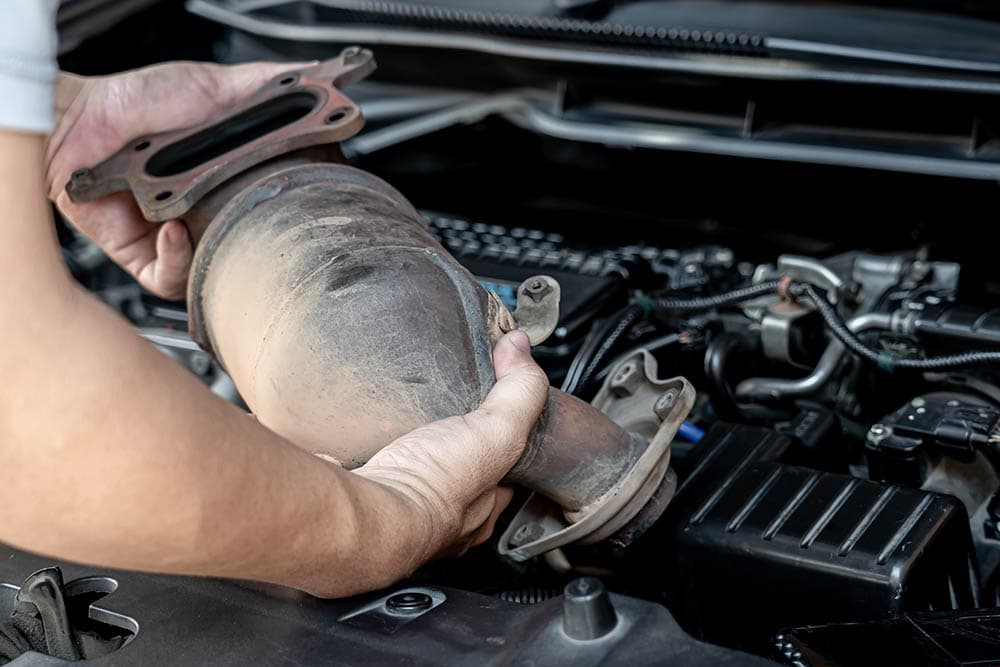How Much Does It Cost to Weld a Catalytic Converter in 2025?
Last Updated on

Are you looking for a reliable welder to weld a catalytic converter on your vehicle and wondering how much it would cost you? If yes, keep reading! We’ll tell you everything you need to know about welding catalytic converters.
Catalytic converters are essential parts of most vehicles. They clean up emissions coming from the engine. Also, these converters do an excellent job of collecting toxic gasses.
Like any other car part, a catalytic converter doesn’t last forever. You’ll need to weld or replace it at some point.
We have put together this guide to help you understand what’s involved with welding a catalytic converter and how much it will cost you. Keep reading to learn more!
Types of Catalytic Converters
A catalytic converter is a part of your car’s exhaust system. It’s designed to reduce the pollution that your vehicle emits. Besides, it cuts down on the number of harmful pollutants by over 50%. It is an intermediary between the exhaust system and the tailpipe. There are mainly two types of catalytic converters, as seen below:
Two-Way Catalytic Converters
This catalytic converter is designed for vehicles that have carburetors. These converters oxidize unburned hydrocarbons and carbon monoxide in the exhaust gasses. Keep in mind that this type of exhaust system will not work on vehicles with fuel injection systems.
Three-Way Catalytic Converters
The three-way catalytic converter is the most common type available today. It’s used on gasoline-powered vehicles, including cars, trucks, and SUVs.
The three-way converter uses platinum, palladium, and rhodium. It reacts with unburned fuel and nitrous oxide to produce carbon dioxide and water vapor.
A catalytic converter is an efficient emissions reduction tool. Also, it increases fuel economy as it burns off excess fuel.
The inside of the converter is coated with ceramic honeycomb coated with a catalyst, such as platinum or rhodium. Fuel particles will pass into the catalytic converter where they are broken down into less harmful gasses. This process continues every time you drive your vehicle until all the catalyst material is used up.
Catalytic converters are made from stainless steel. If it is damaged, you’ll notice a rattling noise that will reverberate through your car when you press down on the gas pedal. If this unit has been knocked loose or damaged, you will need to weld it.
The welding process for a catalytic converter isn’t challenging, but it needs specialized equipment and materials.

The Cost of Welding a Catalytic Converter
Professional car repair services may be a bit costly. So, it’s no wonder that most people are searching for ways to cut costs. If you can do the work yourself, you should save quite a bit of money on repairs.
The welding cost of a catalytic converter depends on the type of vehicle. But you can expect to pay a total of $500 to $2,200 to weld a catalytic converter.
Welding labor costs vary depending on where you live, but they range between $75 and $150 per hour. A mechanic may even replace the converter rather than welding it. The cost of parts alone will start from $400 to $2,000.
Here’s a breakdown of the cost.
| Breakdown | Cost |
| Buying the parts | $400 to $2,000 |
| Labor cost | $75 to $150 |
| Total Cost | $500 to $2,200 |
Factors Affecting the Cost of Welding a Catalytic Converter
Catalytic converters are designed to be durable and long-lasting. So, you don’t have to worry about replacing them until a problem occurs. And because they’re made of metal, it’s possible to weld your catalytic converter if you have the knowledge.
If you decide to have it welded by a professional, several factors can affect the welding cost including:
1. Labor Costs
Labor costs vary depending on where you live. If you live in an area with a high cost of living, the labor cost for welding the catalytic converter will be higher.
2. Type of Repair
There are different types of welding for specific catalytic converter problems. These methods include TIG, MIG, flux, or stick welding. The type of welding needed will affect the cost.
3. Quality of the Weld
You may need to have your catalytic converter welded again if it wasn’t done right the first time. This way, your costs will continue to rise.
4. Costs for Diagnosis
In some cases, you have to pay a diagnostic fee before any work is done on your vehicle. A professional mechanic may need to find out what the problem is and determine how much the repairs will cost.

Does Car Insurance Cover the Cost of Welding a Catalytic Converter?
Car insurance can cover the cost of welding a catalytic converter in some instances depending on the type of coverage. Each one covers a different kind of damage or loss.
If your catalytic converter suffers damage from a collision, and you had collision coverage, it could be covered. You may have it replaced without paying out-of-pocket.
On the other hand, your catalytic converter may need replacement or welding because it was stolen or damaged by vandalism. It can be covered if you have comprehensive coverage.
But, your catalytic converter may need replacement or welding due to normal wear and tear. In this case, your auto insurance policy will not cover it.
Signs Your Car’s Catalytic Converter is Faulty
If your vehicle is having performance issues or sometimes it doesn’t start well, the catalytic converter may be the problem. Here are several signs to look out for:
1. Reduced Fuel Efficiency
If your vehicle’s fuel efficiency has decreased, it can show that something is wrong with your catalytic converter. When your catalytic converter isn’t working well, it doesn’t burn the fuel correctly. So, it wastes more fuel.
2. The Smell of Rotten Eggs
The smell of rotten eggs coming from the exhaust system means something is wrong with the catalytic converter. The sulfur smell indicates damage to the catalyst within the catalytic converter.
3. Check Warning Light
One of the first things most people notice when their catalytic converter fails is the engine light coming on their dashboard. Many different things can cause this, one of them being a clogged or damaged catalytic converter. If this happens to you, don’t ignore it. If left unchecked, it can lead to more severe problems.
4. Poor Acceleration
If the catalytic converter is blocked, it will restrict the flow of exhaust gasses away from the engine. It can result in a loss of horsepower and torque.
If you notice that your car lacks power when you accelerate, you should have it checked out immediately.

Tips for Welding a Catalytic Converter
As the name implies, a catalytic converter is designed to help reduce the pollution of an internal combustion engine. It acts as a catalyst for the chemical reactions that change the emissions into less harmful substances.
The catalytic converter’s basic design and construction are the same for all makes and models of cars and trucks. The tips below can come in handy when welding a catalytic converter for any vehicle.
Choose a Suitable Type of Catalytic Converter for Your Car
Ensure that you have the right catalytic converter. For example, diesel engines require a different converter from gasoline-powered cars.
So, be sure to take your vehicle’s specifications into account. Also, consider the size of the pipe and the number of oxygen sensors.
Note that several universal converters are equipped with both wide and narrow pipes. Also, you may need to cut out the old catalytic converter and weld the new one.
Ensure the Base Welding Surface is Clean
The base welding surface of the exhaust manifold must be clean and free of any dirt or debris. It should also be dry to provide a solid and stable welding surface. Use a wire brush to remove any dirt or debris that could get in the way of a smooth weld.
If there is rust on the manifold’s base, several chemical cleaners are available to remove it. Apply only one of these agents and follow the directions for use carefully.
Choose a Suitable Welding Approach
There are two types of welds commonly used when welding a catalytic converter. They are TIG and MIG. TIG welds use a tungsten electrode as the heat source, while MIG welds use a consumable wire electrode.
While TIG welds are common in repair shops, MIG welding is becoming more popular because it’s easier and less time-consuming while still producing comparable results.
These two welding methods are used because exhaust pipes are manufactured using thin metals and alloys.
Check for Weld Defects
The most common weld defects that occur during the welding of a catalytic converter are porosity and lack of fusion. Porosity is caused by gasses that become trapped in the weld during the process.
Lack of fusion is caused by a failure to fuse the molten weld metal to the base metal. You can inspect your weld for these defects with an electric spark tester. It will show you if there are any cracks or pinholes in your weld seam.
If you want to check for lack of fusion, look closely at your weld to see if it extends through the joint. If you find any defects, correct them immediately.
Final Thoughts
Catalytic converters are an essential part of the exhaust system of your vehicle. They ensure your car complies with emissions standards. Welding a catalytic converter is a specialized job that needs a professional welder.
The cost of welding a catalytic converter is a little different from other welding jobs depending on the type of repair required. It may be cheaper than an exhaust manifold weld, but it is more expensive to have some bolts replaced.
We hope you’ve gained a better insight into how much it costs to have a catalytic converter welded and the factors affecting the final price.
Featured Image Credit: Taphat Wangsereekul, Shutterstock
